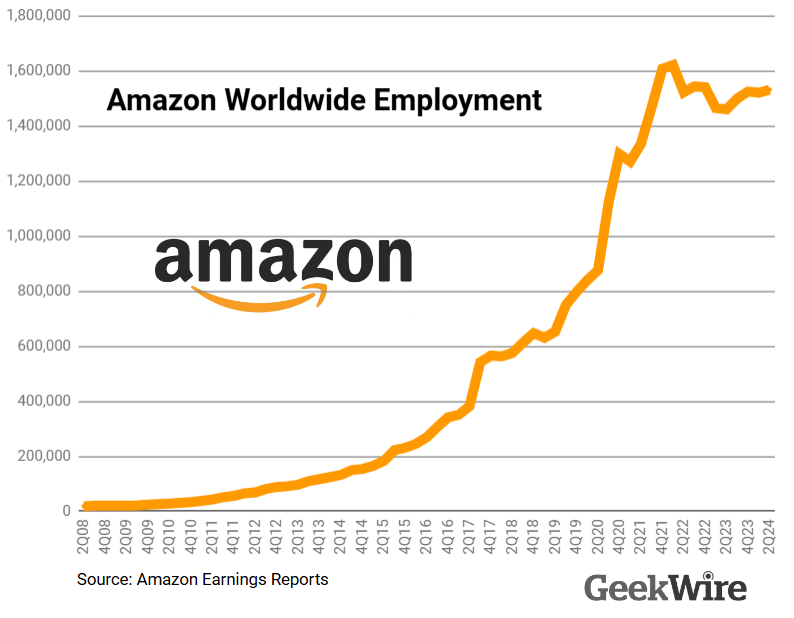Amazon ‘will return to being in the office the way we were’ before the pandemic, CEO tells employees
Amazon expects employees to start working from the office in the same way as they did prior to the global pandemic and the rise of remote work, Amazon CEO Andy Jassy told employees in a memo Monday morning.
The new policy, starting in January 2025, means that employees will be expected to work from the office five days a week unless there are “extenuating circumstances,” Jassy wrote as part of a broader update on Amazon’s culture.
In effect, the shift means that employees will no longer be able to work from home for two days a week by default. Amazon has “decided that we’re going to return to being in the office the way we were before the onset of COVID,” Jassy wrote.
In another major change, Amazon plans to reduce the total number of managers inside its teams, aiming to “increase the ratio of individual contributors to managers by at least 15% by the end of Q1 2025,” Jassy wrote.
The changes could result in the elimination of some management positions, although the scope isn’t clear, and the impact will vary across teams as Amazon’s leaders attempt to achieve the new ratio in the coming months.
Jassy described both moves as part of Amazon’s efforts to “operate like the world’s largest startup,” with streamlined decision-making, in-person collaboration, and fewer layers of bureaucracy.
Amazon’s move to bring corporate and tech workers back for three days a week last year sparked a backlash among some employees and played a role in a protest by employees at its Seattle headquarters.
Employees took to a “Remote Advocacy” Slack channel to air concerns about returning to the office, and some left as a result of the policy.
Taken together, the announcements represent Jassy’s biggest attempt yet to reshape and restore Amazon’s culture since he succeeded Jeff Bezos as CEO of the e-commerce and technology giant in July 2021.
Among other changes, the new office policy means that Amazon will be bringing back assigned desks, no longer using shared or agile workstations in offices where workers had dedicated desks prior to the pandemic.
“Before the pandemic, not everybody was in the office five days a week, every week. If you or your child were sick, if you had some sort of house emergency, if you were on the road seeing customers or partners, if you needed a day or two to finish coding in a more isolated environment, people worked remotely,” Jassy wrote.
He continued, “This was understood, and will be moving forward as well. But, before the pandemic, it was not a given that folks could work remotely two days a week, and that will also be true moving forward — our expectation is that people will be in the office outside of extenuating circumstances (like the ones mentioned above) or if you already have a Remote Work Exception approved through your s-team leader.”

In his memo Monday morning, Jassy reiterated his belief that in-person work is better for collaborating, brainstorming, teaching, learning, and inventing.
“If anything, the last 15 months we’ve been back in the office at least three days a week has strengthened our conviction about the benefits,” he wrote.
The new approach promises to draw attention across the corporate world, where many companies have settled into a hybrid work arrangement in which employees split their time between the home and the office. A report from Flex Index, which tracks flexible work policy trends, found that 79% of tech companies offer flexible work policies, and just 3% have a full-time in-office requirement.
However, Amazon isn’t alone. Other large companies including UPS and JPMorgan Chase are also requiring employees to be back in the office full-time.
In some cases, newly formed startups are also choosing to have employees work in the office five days a week by default, citing the benefits of in-person collaboration, even if it limits the reach of their recruiting.

A study from Stanford University professor Nicholas Bloom found that hybrid work had no effect on worker productivity or career advancement. “Hybrid work is a win-win-win for employee productivity, performance, and retention,” Bloom said.
Separately, a research paper published in May found that back-to-office mandates drive employees away, with senior employees leaving at the highest rates.
As one side effect, Amazon’s policy shift could further boost the businesses around Amazon’s offices that rely on foot traffic, such as restaurants and service providers.
Amazon cut 27,000 corporate and tech jobs globally in two major waves of layoffs in early 2023, starting before it brought employees back to the office for three days a week. The company has since made more targeted job cuts in areas including its health care operations, Twitch, Prime Video, MGM Studios, and Amazon Web Services.
Follow-up: Amazon’s new back-to-office mandate fuels debate over remote work and productivity

